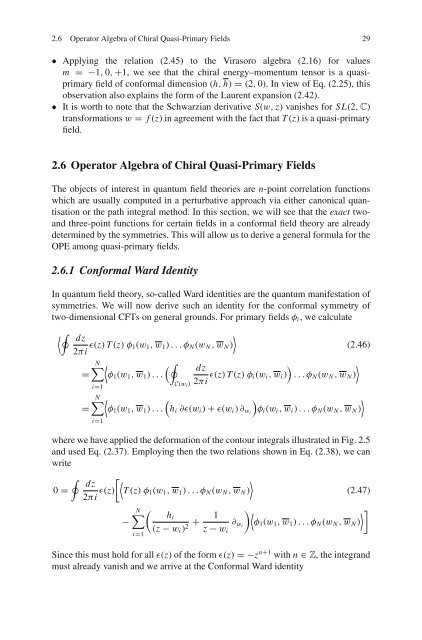Introduction to Conformal Field Theory: With Applications to String ...
Introduction to Conformal Field Theory: With Applications to String ...
Introduction to Conformal Field Theory: With Applications to String ...
Create successful ePaper yourself
Turn your PDF publications into a flip-book with our unique Google optimized e-Paper software.
2.6 Opera<strong>to</strong>r Algebra of Chiral Quasi-Primary <strong>Field</strong>s 29<br />
• Applying the relation (2.45) <strong>to</strong> the Virasoro algebra (2.16) for values<br />
m = −1, 0, +1, we see that the chiral energy–momentum tensor is a quasiprimary<br />
field of conformal dimension (h, h) = (2, 0). In view of Eq. (2.25), this<br />
observation also explains the form of the Laurent expansion (2.42).<br />
• It is worth <strong>to</strong> note that the Schwarzian derivative S(w, z) vanishes for SL(2, C)<br />
transformations w = f (z) in agreement with the fact that T (z) is a quasi-primary<br />
field.<br />
2.6 Opera<strong>to</strong>r Algebra of Chiral Quasi-Primary <strong>Field</strong>s<br />
The objects of interest in quantum field theories are n-point correlation functions<br />
which are usually computed in a perturbative approach via either canonical quantisation<br />
or the path integral method. In this section, we will see that the exact twoand<br />
three-point functions for certain fields in a conformal field theory are already<br />
determined by the symmetries. This will allow us <strong>to</strong> derive a general formula for the<br />
OPE among quasi-primary fields.<br />
2.6.1 <strong>Conformal</strong> Ward Identity<br />
In quantum field theory, so-called Ward identities are the quantum manifestation of<br />
symmetries. We will now derive such an identity for the conformal symmetry of<br />
two-dimensional CFTs on general grounds. For primary fields φi, we calculate<br />
�� dz<br />
2πi ɛ(z) T (z) φ1(w1,<br />
�<br />
w1) ...φN (wN , wN )<br />
(2.46)<br />
=<br />
=<br />
N� �<br />
�<br />
φ1(w1, w1) ...<br />
�<br />
i=1<br />
N� �<br />
�<br />
φ1(w1, w1) ...<br />
i=1<br />
C(wi )<br />
dz<br />
2πi ɛ(z) T (z) φi(wi,<br />
�<br />
�<br />
wi) ...φN (wN , wN )<br />
hi �ɛ(wi) + ɛ(wi) �wi<br />
�<br />
�<br />
φi(wi, wi) ...φN (wN , wN )<br />
where we have applied the deformation of the con<strong>to</strong>ur integrals illustrated in Fig. 2.5<br />
and used Eq. (2.37). Employing then the two relations shown in Eq. (2.38), we can<br />
write<br />
�<br />
dz<br />
0 =<br />
2πi ɛ(z)<br />
�� �<br />
T (z) φ1(w1, w1) ...φN (wN , wN )<br />
(2.47)<br />
−<br />
N�<br />
�<br />
i=1<br />
hi 1<br />
+ �wi<br />
(z − wi) 2 z − wi<br />
�� �<br />
φ1(w1, w1) ...φN (wN , wN )<br />
�<br />
Since this must hold for all ɛ(z) of the form ɛ(z) =−z n+1 with n ∈ Z, the integrand<br />
must already vanish and we arrive at the <strong>Conformal</strong> Ward identity




